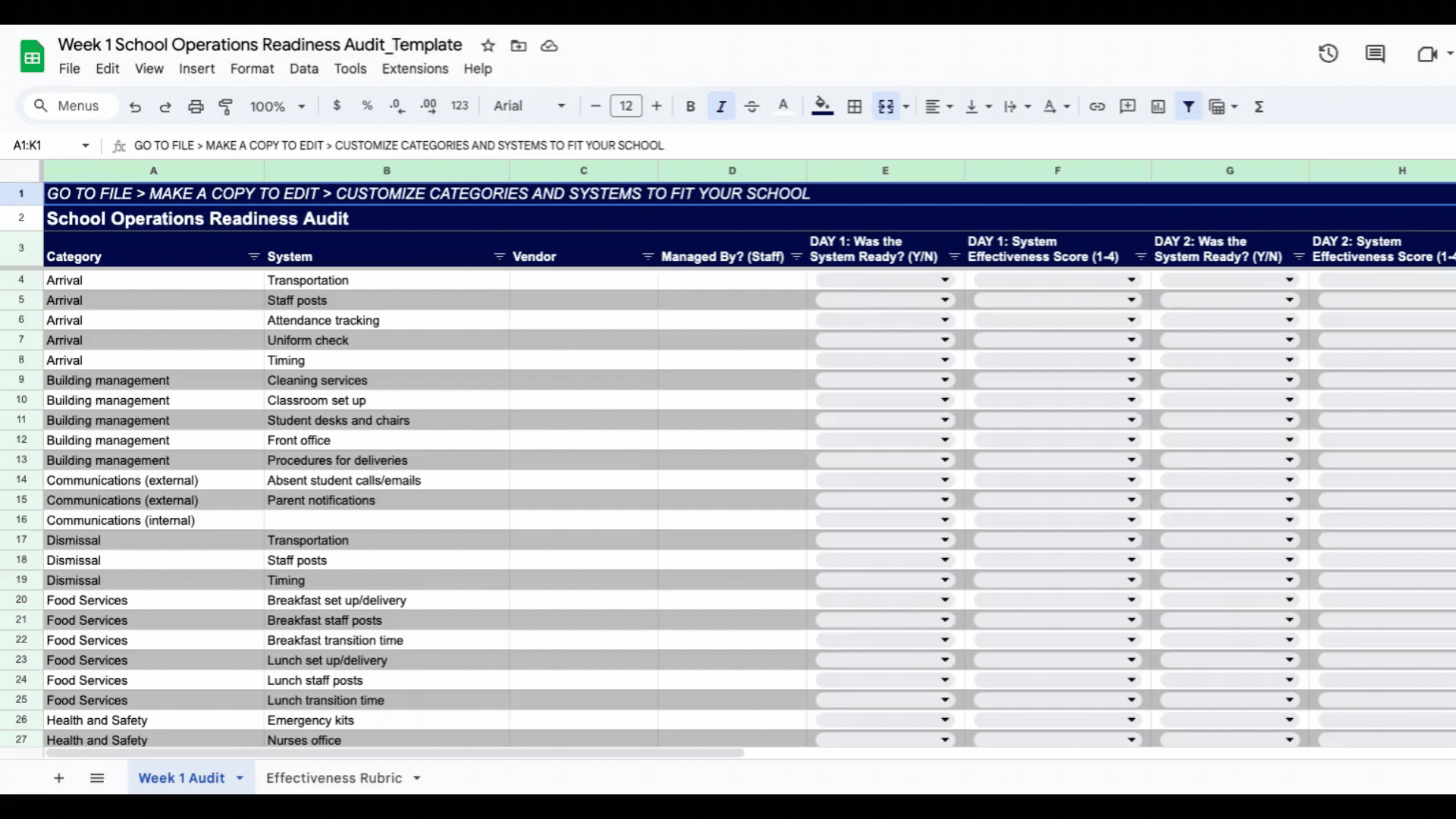Week 1 School Operations Readiness Audit
Set the Tone for a Great School Year
As charter school leaders prepare for the 2024-25 school year, ensuring that all operational systems are ready and effective is crucial for creating a smooth, efficient, and calm school environment. Not all systems will function perfectly as planned (because of the number of humans involved). However, Week 1 offers a critical opportunity to identify issues and make improvements before they negatively impact learning. We created the Week 1 School Operations Readiness Audit to support this work. Download the template and refer to the information below for additional context if needed.
Week 1 School Operations Readiness Audit Template Overview
Now that you’ve downloaded the template, let’s unpack what’s included
The Week 1 School Operations Readiness Audit is a comprehensive tool designed to help school leaders assess the readiness and effectiveness of their operational systems. The audit covers a wide range of categories and systems, including:
1. Arrival Procedures
2. Building Management
3. Communications (Internal and External)
4. Dismissal Procedures
5. Food Services
6. Health and Safety
7. IT/Tech Management
8. School Activities
9. Student Behavior Management
10. Student Materials and Transitions
Customizing the Audit for Your School
Each charter school is unique, and the audit can be customized to fit specific needs. School leaders can add or modify categories and systems to reflect their particular context. Here’s how you can customize the audit:
Make a Copy of the Template: Start by making a copy of the provided spreadsheet template. This will allow you to edit and tailor the audit to your school’s requirements.
Define Systems and Criteria: For each category, define the specific systems you want to assess. For example, under Arrival Procedures, you might include transportation, staff posts, attendance tracking, uniform checks, and timing.
Set Effectiveness Criteria: Establish clear criteria for assessing the effectiveness of each system. Here’s an example for the Transportation system under Arrival Procedures:
1 - Unsatisfactory: Buses never showed up
2 - Needs Improvement: Buses late by 15+ minutes
3 - Proficient: Buses arrived within 5 minutes of arrival time
4 - Exemplary: Buses arrived on time
Conducting the Audit
The audit should be conducted over multiple days to get a comprehensive view of system readiness and effectiveness. Here’s a step-by-step guide:
Prepare for the Audit: Ensure all staff members understand the purpose and process of the audit. Assign specific roles and responsibilities for conducting the audit and gathering data.
Collect Data: On each day of the audit, assess the readiness and effectiveness of each system using the predefined criteria. Record whether the system was ready (Yes/No) and assign an effectiveness score (1-4).
Analyze Results: After collecting data over multiple days, analyze the results to identify patterns and areas for improvement. Look for systems that consistently score low and investigate the underlying causes.
Develop Action Plans: Based on the audit results, develop action plans to address areas of weakness. This might involve additional training for staff, revising procedures, or investing in new resources or technologies.
Implement Improvements: Put the action plans into practice and monitor their impact. Continue to use the audit tool periodically to assess progress and make further adjustments as needed.
Sample Systems and Effectiveness Criteria
To give you a better idea of how to fill in the audit, here are some example systems and criteria for a few key categories:
Arrival Procedures
Transportation:
1 - Unsatisfactory: Buses never showed up
2 - Needs Improvement: Buses late by 15+ minutes
3 - Proficient: Buses arrived within 5 minutes of arrival time
4 - Exemplary: Buses arrived on time
Staff Posts:
1 - Unsatisfactory: Staff not present
2 - Needs Improvement: Staff arrive late
3 - Proficient: Staff on time but not fully engaged
4 - Exemplary: Staff on time and fully engaged
Attendance Tracking:
1 - Unsatisfactory: No attendance taken
2 - Needs Improvement: Incomplete attendance records
3 - Proficient: Attendance is taken but with delays
4 - Exemplary: Accurate and timely attendance tracking
Building Management
Cleaning Services:
1 - Unsatisfactory: Areas not cleaned
2 - Needs Improvement: Inconsistent cleaning
3 - Proficient: Generally clean but some issues
4 - Exemplary: Spotless and well-maintained
Classroom Set Up:
1 - Unsatisfactory: Classrooms not set up
2 - Needs Improvement: Set up incomplete or disorganized
3 - Proficient: Set up complete with minor issues
4 - Exemplary: Well-organized and fully prepared
Student Desks and Chairs:
1 - Unsatisfactory: Insufficient or broken desks/chairs
2 - Needs Improvement: Some issues with quality or quantity
3 - Proficient: Adequate but could be improved
4 - Exemplary: High-quality and sufficient for all students
Food Services
Breakfast Set Up/Delivery:
1 - Unsatisfactory: Not set up or delivered
2 - Needs Improvement: Late or incomplete setup
3 - Proficient: Set up but with minor issues
4 - Exemplary: On time and complete
Lunch Set Up/Delivery:
1 - Unsatisfactory: Not set up or delivered
2 - Needs Improvement: Late or incomplete setup
3 - Proficient: Set up but with minor issues
4 - Exemplary: On time and complete
Transition Time:
1 - Unsatisfactory: Chaotic and disorganized
2 - Needs Improvement: Delays and minor issues
3 - Proficient: Smooth but could be faster
4 - Exemplary: Efficient and orderly
Conclusion
The Week 1 School Operations Readiness Audit is an essential tool for charter school leaders as they prepare for the new school year. By systematically assessing and improving the readiness and effectiveness of various operational systems, schools can create a more efficient and supportive environment for students and staff alike. Customizing the audit to fit your school’s unique needs and using the data to drive continuous improvement will help ensure a successful start to the 2024-25 school year.

